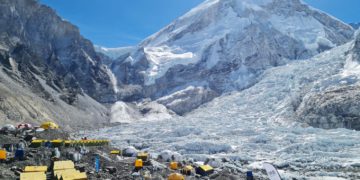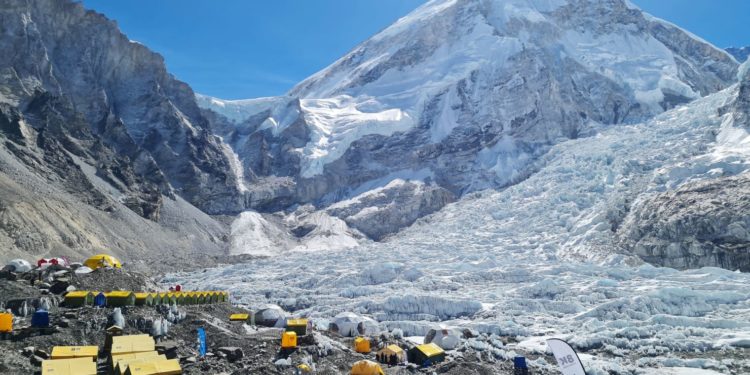It’s that time again: Mount Everest season.
For two months starting in March, thousands of ambitious voyagers are set to travel more than 16,000 feet above sea level to one of Everest’s two main campsites. But this adventure of a lifetime—dangerous, difficult, and deadly as it is—can also be a very luxurious experience for those willing to pay up.
“There was a [Everest guide] company last year that offered a masseur from Kathmandu, who stayed the whole season,” Alan Arnette, a mountaineering coach who successfully climbed Everest in 2011, told The Daily Beast. “If you’re paying $100,000, you can expect cappuccinos and sushi up there. Even a three-star chef.”
Some of the most opulent adventurers arrive at the base camp of the world’s largest mountain, with hired porters carrying their gear in tow, before being to glamping-style tents that offer a slew of amenities rivaling any five-star hotel.
“There is a market for the high-end experience at Basecamp. It’s like an airplane. The experience is totally different the more you spend,” Arnette added.
This luxury mountainous accommodation is just another example of the fast-growing adventure travel market for enthusiasts willing to shell out hundreds of thousands of dollars for once-in-a-lifetime trips to space, the bottom of the ocean, and even the South Pole. Unlike other excursions that seem only available to those with a vastly expendable income—-the price tag on a trip to Everest can vary greatly.
Expedition organizers and former Everest climbers told The Daily Beast that the cost for the mountain trip ranges from $30,000 to over half a million dollars—excluding the airfare to Asia. The trip consists of three major costs: a permit that costs upwards of $18,000 to climb on either the Nepal or China side; payment to the guide company that supplies the tents, oxygen sherpa, and other necessities; and purchasing all the gear to safely summit the 29,000-foot mountain.
On the Nepal side, travelers are also set to walk 80 miles, or a 9-day trek to base camp—while those who decide to go through China can drive to the site.
“If you have nothing, the list price for all the gear would be about $18,00 to start from scratch,” Arnette explained, noting that only 400 people climb the summit of Everest. “But most people, by the time they get to Everest, have some gear already.”
Once at base camp, travelers at every price range can enjoy the once-in-a-lifetime views from one of the natural wonders of the world. Arnette admitted that while photography at the snow-topped, rocky mountain is not new, the rise of social media has changed how travelers document their adventures.
“These are selfie climbers. They are going for the summit selfie,” he said. “With Instagram and Twitter, there is certainly no shortage of pictures of Everest. So, you see the trash, dead bodies, and people having champagne at camp all on the internet.”
That means, the hefty price tag usually comes down to the type of guide package.
Among the most luxurious is the $98,000 per person Mount Everest North Side Rapid Ascent Expedition by Alpenglow Expeditions. The 36-day trip is on the north side of Everest in Tibet, where advanced explorers will enjoy small group sizes, an on-call doctor, nine bottles of oxygen, and an imported cook served an “a western-train cook staff.” At the company’s 26,000-foot base camp infrastructure, Alpenglow travelers have access to dining tents, wifi, cell service, and a fully stocked kitchen.
Furtenbach Adventures also aspires to give its consumers a true “glamping” expedition experience at the modest price of $75,000. “Every climber has a two-room stand-up tent with a bed, desk, electricity, and Wi-Fi, and large lounge tents with a bar, movie screening, library, and hot showers. Last year we even had a sauna and infrared cabin powered with a clean fuel cell,” founder Lukas Furtenbach told The Times of London in 2020. “And wherever possible clients can fly in and out from base camp by helicopter.’
The luxury perks can even start at home.
Arnette explained that some people invest in altitude tents to prepare you for the conditions on Everest, which can cut down the traditional eight-week trip down the mountain to two weeks. “There is essentially a plastic bubble that simulates high altitude at home so you can start the acclimatization process at home,” Arnette said. “You sleep in them two months before you go on your trip.”
Ryan Waters, a professional climber and owner of a guide company, explained that while normal ranges for trips “vary quite a lot,” anything with less than a $40,000 price tag “would raise red flags” since it may be sacrificing some essential safety measures.
That warning is justified, considering over 300 people have died attempting to reach—or return—from the mountain’s summit. Last year, 17 people lost their lives on their way to or back from the summit, and eight have died this year alone.
“On the upper end, the sky seems to be the limit, I have heard about trips over 250,000, and to me it is just a selling feature that someone thinks they are getting some miraculous extras but most likely someone paying that is just wanting to say they are paying the most for a trip,” Waters, whose company has guiding Everest since 2008, told The Daily Beast. “But not getting much in reality over real normal western guide company offerings.”
A sherpa-led general expedition for Waters’ company, Mountain Professionals, runs about $49,500—and increases to $65,000 with a western or American mountain guide leading the small team. For $100,000, he said, climbers can enjoy a privately guided trip.
Regardless of the tier, all Mountain Professional climbers enjoy a slew of amenities at the company’s large multi-domed base area, including a dining dome and a hangout dome equipped with heat, carpets, wifi, couches, and “lots of great food and coffee.”
“Plus personal very large box tents for each climber while at base camp that have carpet, a bed mattress, pillow, storage area, charging, wifi, etc,” Waters explained. “In addition a propane heated shower, lots of toilet tents, and then staff domes and kitchen for our staff.”
Mark Synnott, a professional climber who submitted Everest in 2019, told The Daily Beast that while he didn’t shell out for high-end accommodations the last time he went to the mountain—he still enjoyed the perks.
“You hang out with the people that are staying at the highest-end spots,” he said. “They had this big dome tent and when you go inside, you immediately see an espresso machine. And then in their glamping tents, they have a foyer, a desk, and even a bedroom with a little bed.”
He said he would enjoy their “fizzy water” and coffee at the luxury digs, before returning to his “regular tents.”
Another perk that comes with the more expensive guide package, he explained, is access to more high-flow rate oxygen during the actual summit. “A higher flow rate allows for an easier time climbing,” Synott explained.
But the luxurious glamping might not last for long—if the Nepalese officials have anything to say about it. The Telegraph reported in March that local officials are trying to limit the number of travelers and restricting luxury sites in order to protect the mountain.
Synott explained that while the luxury campsites might seem over the top, they only appeal to a small portion of Everest mountaineers. Most people he met on the mountain were “not rich,” he said, but “scrappy dreams” who saved up for a long time to climb Everest.
“I would say you get about 10 percent of people at Everest that are just rich and doing it for bragging rights, about another 10 percent that don’t know what they are doing, and everyone else there works hard and spends a long time saving the money and has experience climbing,” Arnette said.
“It’s certainly one of the most experienced Instagram photos, but also so in owning a horse or sailing around the world,” he added.
The post Spa, Sushi, Posh Digs: The Bougiest Way to Climb Everest appeared first on The Daily Beast.



















